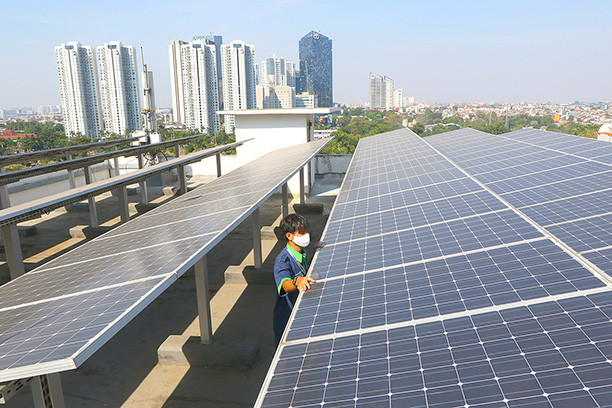Popular Reads
Top Results
Can't find what you're looking for?
View all search resultsPopular Reads
Top Results
Can't find what you're looking for?
View all search resultsIndonesia's rise as Southeast Asia's premier green energy powerhouse
Establishing policies to stimulate adoption and demand for renewable energy is the first imperative. This includes tax credits and subsidies to reduce the cost of purchasing and installing renewable energy systems.
Change text size
Gift Premium Articles
to Anyone
Indonesia is home to abundant natural resources, with the potential to become a regional powerhouse in the green energy space.
Indonesia has an estimated 400 gigawatts (GW) of technical potential for renewable-based power generation. Solar accounts for half of that figure, while hydropower and geothermal could deliver up to 75GW and 29GW capacity respectively. If fully developed, this is more than enough to meet Indonesia’s future demand — however, the pace of the energy transition must be carefully managed to ensure a just transition.
This encouraging outlook reveals Indonesia’s substantial green energy opportunities, with renewables able to deliver as much as two-thirds of the nation’s total energy mix by 2050 — up from just 14 percent today.
Indonesia also holds significant potential as a center for carbon capture and storage (CCS), with an estimated four to eight gigatons of carbon dioxide (CO2) storage potential by leveraging depleted oil and gas reservoirs. Utilizing Indonesia’s saline aquifers could add an additional 600 billion tons of CO2 storage potential. This CCS opportunity could significantly accelerate the journey to reduce national CO2 emissions.
Indonesia is also positioned to become one of the region’s leading producers of green molecules. As an emerging economy with a growing industrial sector, there is an increasing demand for industries such as steel, cement and chemicals switching to green hydrogen to accelerate their decarbonization. The demand for green hydrogen across Asia is projected to reach more than 300 million tonnes per annum (mtpa) by 2050.
Potential regional energy hub
With its significant renewable energy and CCS potential, Indonesia can go beyond meeting its own green energy needs, and act as a regional hub to catalyze the wider decarbonization of Southeast Asia. Its strategic geographical location enables connections with nearby nations through existing and emerging energy interconnections, backed by government commitments to advance renewable energy. This means Indonesia can offer a platform to accelerate decarbonization of neighboring countries in Southeast Asia.
This potential is aligned with Indonesia’s commitment to grow the share of renewable energy in the national energy mix, supported by policy interventions and incentives for renewable energy technologies. This could position Indonesia as a leading player in Southeast Asia’s green energy landscape.
Realizing Indonesia’s potential as a regional green energy hub relies on ensuring fast-track adoption of renewable energy, putting in place the right policies, developing infrastructure and enhancing capabilities across the supply chain to help accelerate the development of renewable energy and CCS technologies.
Singapore’s import of 2GW of green electrons from Indonesia is an important step. A power export agreement, signed in January 2022 and March 2023, affirms both countries’ commitments to facilitate cross-border electricity trading and interconnections, while also energizing investments in the development of renewable energy manufacturing industries. Exporting green electrons also provides the opportunity to kickstart Indonesia’s domestic renewable energy value chain by compensating for low green electricity demand in the short term. Developing renewable energy manufacturing capabilities can also ensure the security of supply in the long run.
While the potential is significant, realizing this ambition to be a regional green energy powerhouse requires bold moves and policy interventions across demand and supply, as well as enabling infrastructure and collaboration with stakeholders. There are several strategic imperatives for the successful export of green electrons.
Accelerating adoption of renewable energy technologies
Establishing policies to stimulate adoption and demand for renewable energy is the first imperative. This includes tax credits and subsidies to reduce the cost of purchasing and installing renewable energy systems. These incentives make green energy more financially accessible to a broader range of consumers and businesses.
Other countries have launched incentives and subsidies to accelerate adoption of renewable energy technology. For example, the United States’ Investment Tax Credit (ITC) is an incentive that reduces federal income tax liability for a share of the cost of a solar energy system installed during the tax year. ITC allows homeowners and businesses to deduct a percentage of the cost of installing solar energy systems from their federal taxes. Furthermore, solar energy systems that meet domestic content thresholds are eligible for a 10-percentage point increase in the value of ITC.
In India, the government offers a range of subsidies and incentives for solar panel installations under its National Solar Mission. This includes capital subsidies and rebates, as well as tax benefits for both residential and commercial installations.
In addition to the range of subsidies and incentives, setting clean energy standards or renewable portfolio standards in the medium term, requiring companies to source a certain share of their energy from renewable sources, will also further accelerate the adoption of renewable technology in the domestic market.
Ensuring green energy investment for developers, investors
It is important to embed an attractive economic environment for investors and operators. Government support in the form of tax incentives for manufacturers and developers, and subsidies and grants for research and development (R&D), play an important role in promoting renewable energy.
There are several potential policy levers that could be introduced to incentivize investment. Commercial tariff premiums or above-market rates for renewable energy fed into the national grid can be considered to ensure attractive investment returns for power developers that encourage participation.
It is also important to ensure transparent markets and stable policies. A clear, communicated plan for ramping up renewable energy backed by coherent national energy policies that offer long-term stability is vital for investor confidence. Market data should be transparent and accessible to help investors make informed decisions and reduce perceived risks.
Capabilities, infrastructure and regional collaboration should be strengthened to fast-track Indonesia’s development as a green energy hub.
Several initiatives are required to establish suitable energy infrastructure. Firstly, strengthening and upgrading the domestic power grid to accommodate a growing share of renewable energy sources is essential. This includes investing in smart grid technology, enhancing grid stability and improving energy storage capacities to handle the variable nature of renewable energy sources like solar and wind.
Scaling capability development in green technologies is also key, particularly for emerging opportunities such as green hydrogen and CCS. The government can allocate funding to R&D activities to support this transition. Government support for research institutions, collaboration with universities and incentivizing private sector R&D through tax benefits or direct funding will support this. Coherent policies across demand, supply and infrastructure should be established to ensure the acceleration of capability development across the green value chain.
In addition, accelerating the development of Indonesia’s carbon market and implementing suitable carbon taxes are also important to accelerate the development of a green ecosystem and unlock large pools of potential funding.
Finally, regional collaboration is vital to connect opportunities across Southeast Asia. Partnership is key to developing electricity trading agreements, infrastructure deployment and other licensing requirements. The ASEAN Power Grid, for example, is a crucial initiative to build regional power interconnection between countries within Southeast Asia, which will then enable trade of green electrons across borders.
With the right interventions across demand, supply and the enabling ecosystem, Indonesia is poised to emerge as the green energy hub for Southeast Asia. In turn, Indonesia’s new position as a regional green powerhouse will help unlock significant economic and social benefits for the nation.
***
Marko Lackovic is a managing director and partner, while Fachry Frisandi a principal at Boston Consulting Group.











